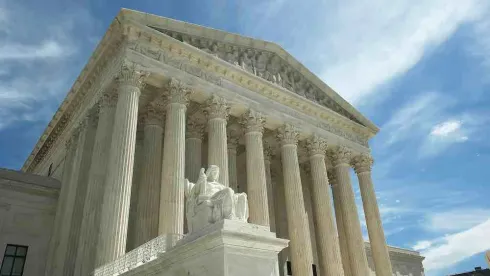The U.S. Supreme Court has agreed to review a case to clarify the scope of attorney-client privilege in the context of dual-purpose communications. In re: Grand Jury, No. 21-1397.
The Court will consider which of two competing standards to apply when determining whether attorney-client privilege protects communications that incorporate both legal and non-legal or business advice.
Attorney-Client Privilege
“Attorney-client privilege” protects certain communications between attorneys and clients from disclosure. The Court extolled the importance of the rule in 1981, when it last addressed attorney-client privilege in Upjohn Co. v. United States, 449 U.S. 383. The Court explained that the purpose of the privilege “is to encourage full and frank communication between attorneys and their clients, and thereby promote broader public interests in the observance of law and administration of justice.” The Court continued, “The lawyer-client privilege rests on the need for the advocate and counselor to know all that relates to the client’s reasons for seeking representation if the professional mission is to be carried out.”
When and how attorney-client privilege attaches is murkier when the communications are “dual-purpose,” involving both legal and non-legal advice. Dual-purpose communications occur often between in-house counsel and internal stakeholders or when law firms provide both business and legal services to clients. The facts of In re: Grand Jury center on the latter example.
Ninth Circuit’s Analysis
The unnamed petitioner is a law firm specializing in international tax law. As part of its practice, the firm advised a client company on the tax consequences of moving its operations out of the United States. The law firm completed a form certifying the company’s compliance with expatriation tax requirements and prepared income tax returns for the client — all of which comprised the substance of the law firm’s communications with the company.
The government began a criminal investigation of the company and its owner and issued grand jury subpoenas requesting documents and communications related to the tax expatriation. The law firm withheld certain communications as protected by the attorney-client privilege. The government moved to compel disclosure. Arguing that the attorney-client privilege did not apply to the documents, the government filed motions to hold the law firm and its client in contempt.
The district court granted the government’s motions. The U.S. Court of Appeals for the Ninth Circuit affirmed the lower court’s decision. 23 F.4th 1088 (2022). The Ninth Circuit analyzed the dual-purpose communications at issue and determined that the “primary purpose” of the communications was providing advice around tax strategy. Under the Ninth Circuit’s analysis, attorney-client privilege did not shield the communications from disclosure.
Split in the Circuits
Circuit courts analyze the application of the attorney-client privilege to dual-purpose communications under one of two similar, but distinctly different, frameworks: “primary purpose” or “significant purpose.”
The Ninth Circuit joined the Second, Fifth, and Sixth Circuits in adopting the “primary purpose” test. Under this test, “the scope of the attorney-client privilege is defined by the purpose of the communication.” In effect, courts must determine the “primary purpose” of the communication. If that primary purpose is to provide legal advice, then attorney-client privilege attaches. Otherwise, the communication is not protected by the privilege.
The U.S. Court of Appeals for the D.C. Circuit adopted the “significant purpose” test when analyzing dual-purpose communications. When he was on the D.C. Circuit Court, Justice Brett Kavanagh applied the “significant purpose” test in In re Kellogg Brown & Root, Inc., 756 F.3d 754 (D.C. Cir. 2014). Under this framework, courts must ask, “Was obtaining or providing legal advice a primary purpose of the communication, meaning one of the significant purposes of the communication?” In other words, “if one of the significant purposes of the [communication] was to obtain or provide legal advice, the privilege will apply.” Kavanaugh had criticized the “primary purpose” test, stating:
trying to find the one primary purpose for a communication motivated by two sometimes overlapping purposes (one legal and one business, for example) can be an inherently impossible task. It is often not useful or even feasible to try to determine whether the purpose was A or B when the purpose was A and B. It is thus not correct for a court to presume that a communication can have only one primary purpose.
The U.S. Court of Appeals for the Seventh Circuit is the only federal appeals court to reject both tests in the context of tax advice. In the Seventh Circuit, attorney-client privilege never attaches to dual-purpose communications that involve tax advice, regardless of the primary or significant purpose of the communication.
Potential Impact on Employers
While the primary purpose test and the significant purpose test are similar, the test the Supreme Court adopts will potentially have far-reaching consequences for law firms and in-house counsel in the employment context.
The Court could issue an expansive ruling that applies to dual-purpose communications in all contexts, or it could limit its holding to dual-purpose communications in the context of tax law. If the Court adopts the primary purpose test, the bar for invoking attorney-client privilege in the context of dual-communications will be high. If the Court adopts the primary purpose test in a broader context, in-house and outside counsel for employers may need to consider separating communications seeking legal advice from other types of communications to ensure the protection of the attorney-client privilege.
On the other hand, friend-of-the-court briefs from legal and business organizations encourage the Court to adopt the D.C. Circuit’s significant purpose test. They argue that the primary purpose test fails to reflect the modern realities of law practice, in which lawyers offer advice to clients on diverse legal and business issues. Conversely, the significant purpose approach relieves courts of the burden of weighing the legal and non-legal implications of a communication to determine its dominant purpose.
The Court’s decision will provide clarity and consistency. A unified approach will benefit all employers that do business in multiple circuits by providing a more predictable framework for analyzing dual-purpose communications.





 />i
/>i

